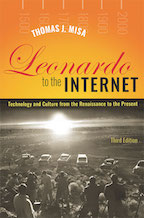| READING
QUESTIONS Leonardo to the Internet: Technology and Culture from the Renaissance to the Present Thomas J. Misa Johns Hopkins University Press, 2022; 3rd edition |
 |
|
WWW sites:
Chapter 6. Materials of Modernism (1900-1950)What characteristics of glass and steel (but not wood
or stone) appealed to modern architects? "Our forebears drew their artistic inspiration from a
religious atmosphere which fed their souls; in the
same way we must breathe in the tangible miracles of
contemporary life," the Futurists claimed in
1910. What values did Futurists -- Marinetti, Boccioni,
Balla, Sant'Elia -- associate with technology?
DISCUSS three specific
Futurist works (manifestos, painting, sculptures,
buildings). De Stijl
transformed Futurist thinking into a set of
architectural theories about modern materials and
cultural development. What values did Doesburg,
Mondrian, Oud, and Berlage associate with
technology? DISCUSS
three specific de Stijl works.
The Bauhaus
synthesized theory and practice and created the most
influential theory of modernism in architecture.
What values did Gropius, Mies van der Rohe, Lazlo
Moholy-Nagy, Ernst May and Martin Wagner associate
with technology? DISCUSS
two specific Bauhaus works. Discuss Lihotzky's "Frankfurt kitchen" (fig. 6.6) as
an ironic "icon" of modernism. Using this chapter, explain how modernism offers a vivid instance of "how technology changes society."
|
||